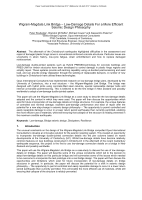Bridges

- Publication no: ABC2017-118-17
- Published: 26 April 2017
- PDF (free) Download
The aftermath of the Christchurch earthquake highlighted difficulties in the assessment and repair of damaged plastic hinge zones in conventional reinforced concrete structures. Particular issues are uncertainty in strain history, low-cycle fatigue, strain embrittlement and how to replace damaged reinforcement.
Low-damage ductile-jointed systems such as Hybrid PRESSS-technology for concrete buildings and PRES-LAM for timber structures have been developed to control damage in plastic hinge regions and simplify repair. These systems provide self-centring capability using un-bonded post-tensioning and axial load, and can provide energy dissipation through the yielding of replaceable dampers. A number of new buildings in Christchurch have utilised these technologies.
Opus International Consultants has implemented research on low-damage bridge piers, developed by the University of Canterbury, into a real structure – the Wigram-Magdala Link Bridge. The bridge was designed with hybrid joints using concrete-filled steel columns, special replaceable damper bolts and internal un-bonded post-tensioning. This is believed to be the first bridge in New Zealand and possibly worldwide to adopt a low-damage ductile-jointed system.
This paper will use the Wigram-Magdala Link Bridge as a case study to describe the low-damage details adopted and the context in which they were used. The paper will then discuss the opportunities which exist for future incorporation of low-damage details on bridge structures. For example, the unique features of controlled and minimal damage, excellent post-damage performance and ease of repair offer the potential for a new step-change in seismic design philosophy – The opportunity to permit controlled and easily repairable damage to occur in a lower return period earthquake than currently permitted, enabling the more efficient use of materials, whilst still ensuring that collapse of the structure is reliably prevented in the maximum credible earthquake.
